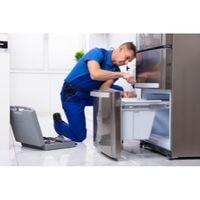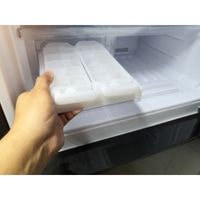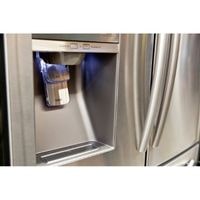Kitchenaid refrigerator repair. There are many common KitchenAid refrigerator problems that aren’t as serious as they sound and once you understand them, you’ll find that doing the repair yourself will save you a lot of time.
There could be an issue with your KitchenAid’s temperature control or freezer, like an ice maker that will not dispense ice. Stay calm. You came to the right place.
Kitchenaid refrigerator repair
Here at Housetipper, we aim to provide you with information that allows you to complete repairs on your own – before outsourcing it to a technician.
We’ve all felt the frustration of paying for expensive help when employees are more costly than ever.
Here’s an easy-to-follow instruction guide on how to try your part in getting your refrigerator working again.
The Kitchenaid refrigerator is leaking
If the defrost drain is frozen, you will see a mess on the floor or not, depending on whether your fridge is under the counter. Eventually, the water can leak onto the floor.
If you notice that there is a problem with your refrigerator, take action immediately, as it could cause problems for other parts as well.
One way to prevent this from happening relies on knowing how to remove blockages from the defrost drain before they become an issue.
To do so, first ensure that the water in the compartment has been sweated where it ran down from the evaporator plate and collected around the drain opening.
Be sure to check frequently, as these clogs usually freeze fast after a few cycles! Do not attempt to move heavy ice without proper tools and care.
The temperature isn’t cold enough
Keeping a refrigerator at a steady temperature is vital for preserving foods. The best way to achieve a consistent temperature is to check the thermostat in your fridge, ensure that there isn’t any obstruction from any gasket or seal, and clean the coils with a vacuum.
The thermostat does not likely need to be replaced if it clicks. If the thermostat does not click, test its continuity with a multimeter. Replace the temperature control thermostat if there is no continuity in any setting.
It makes an unusual noise
If the kitchen appliance is noisy or loud, especially when one of the doors is opened, check to see if the evaporator or condenser fan blade is the culprit.
If the fan blade does not turn freely, turn it by hand, then check to see if the blade is caught on something or if there’s some other debris that may be causing this issue.
Additionally, check underneath both sides of your refrigerator to ensure that your blades aren’t obstructed by anything and to reveal any problems you might have in this area.
Ice maker does not work
The reason you can’t make ice can be frustrating. Essentially your ice maker is no longer working the way it should be, i.e., there’s something wrong with it, and while some of these parts are available separately.
You might need to replace the entire component (which is not necessarily too expensive). Assuming your freezer temperature is at least 15 degrees Fahrenheit, check the water inlet valve, water line, and fan for possible defects/irregularities.
If none of these parts are faulty or defective, then ultimately, replacing the broken ice maker might be the only solution that works for you.
The water dispenser does not work
To test if the water supply tube is frozen, disconnect it at the base of the door and blow through. If you cannot pass air through, this indicates that the water supply hose is frozen beneath your fridge.
If your water hose becomes blocked with ice, thaw it out by either leaving the door open of the freezer section of the appliance or using a hairdryer on its warm setting (please exercise caution if you use a hairdryer).
It’s also important that your freezer compartment is kept at -10°C or colder to stop future freezing from occurring.
A KitchenAid refrigerator won’t defrost
The defrost heater assembly uses an electric heating element to melt away any ice that builds upon the evaporator coils.
Thus, when this part is defective, your defrost system will not work properly, and you will not be able to efficiently distribute heat throughout your home on a cold day.
First, check to see if the defrost heater assembly is completely intact or weak by checking its continuity with a multimeter. Once you find out it’s been damaged somehow, order a new defrost heater and replace it right away.
The KitchenAid refrigerator freezes food
The thermistor senses air temperature and sends the reading to the control board. The control then regulates the supply of power to the compressor and fan depending on thermostat readings.
Thermistors collect data that helps manage refrigerator coils. If it gets too cold in your refrigerator, thermistors might stop working properly, so check them with multimeter probes.
Their resistance is supposed to change in accordance with temperature, so if they don’t change resistance when you test them with a multimeter tool, it means they are toast.
The KitchenAid refrigerator runs continuously
Refrigerators depend on the cooling power of their condenser coils. These refrigerator coils are located at the bottom of the fridge, under the crisper or drawer area.
All new refrigerators have automatic defrost systems, but you will need to clean them every few months to prevent build-up issues.
If refrigerator coils remain clogged with debris over time, the energy efficiency of your refrigerator suffers. In an attempt to cool down, the refrigerator will run continuously.
A dirty appliance produces more heat, so if you don’t keep up with this maintenance, your electric bill will continue to be high even when your food items may not stay frozen as long during use.
Kitchenaid refrigerator repair ( 2022 Complete Guide)
Related Guides
